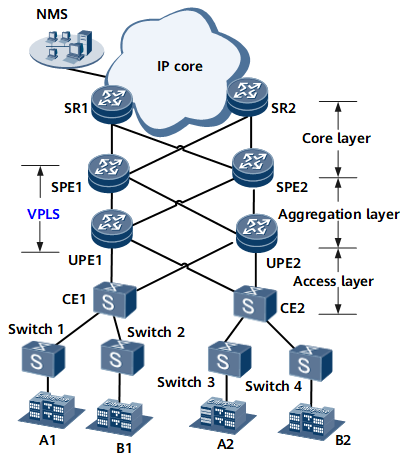Application of VPLS in Enterprise Services
Service Overview
As enterprises set up more and more branches in different regions and office flexibility increases, applications such as instant messaging and video conference are increasingly widely used. This trend imposes high requirements for E2E datacom technologies. A network capable of providing P2MP services is the key to datacom function implementation. To ensure enterprise data security, secure, reliable, and transparent data channels must be provided for multipoint transmission.
To meet the preceding requirements, VPLS is used on carriers' MANs to implement communication between different branches of an enterprise.
Networking Description
Enterprise services are transmitted to the Internet over the access layer, aggregation layer, and core layer of a MAN. Figure 1 shows the typical networking for enterprise services. An enterprise has one branch in city 1 and one branch in city 2. A1 and A2 are R&D departments whereas B1 and B2 are financial departments. VPLS is configured to ensure that the R&D departments can communicate with each other, the financial departments can communicate with each other, but the R&D departments cannot communicate with the financial departments.
Feature Deployment
VPLS is configured on PEs to transparently transmit traffic between them. From the perspective of enterprise users, the public network is like a Layer 2 switch. Figure 1 uses LDP VPLS as an example to show VPLS configuration:
Access-layer devices
QinQ is configured to differentiate different types of enterprise users.
Aggregation-layer devices
An Interior Gateway Protocol (IGP) is configured on PEs for these PEs to communicate with each other.
Basic MPLS functions are configured on PEs so that these PEs can establish remote LDP sessions. MPLS TE tunnels are established between PEs, and TE FRR is configured on these PEs.
MPLS L2VPN and VSIs are configured on PEs. Dual-homing is used on a VPLS network to protect traffic.
Limit on the number of learnt MAC addresses and traffic suppression are configured on PEs to protect data.
Core-layer devices
IGPs are configured on SRs so that these SRs can communicate with each other.
Basic MPLS functions are configured on SRs.
